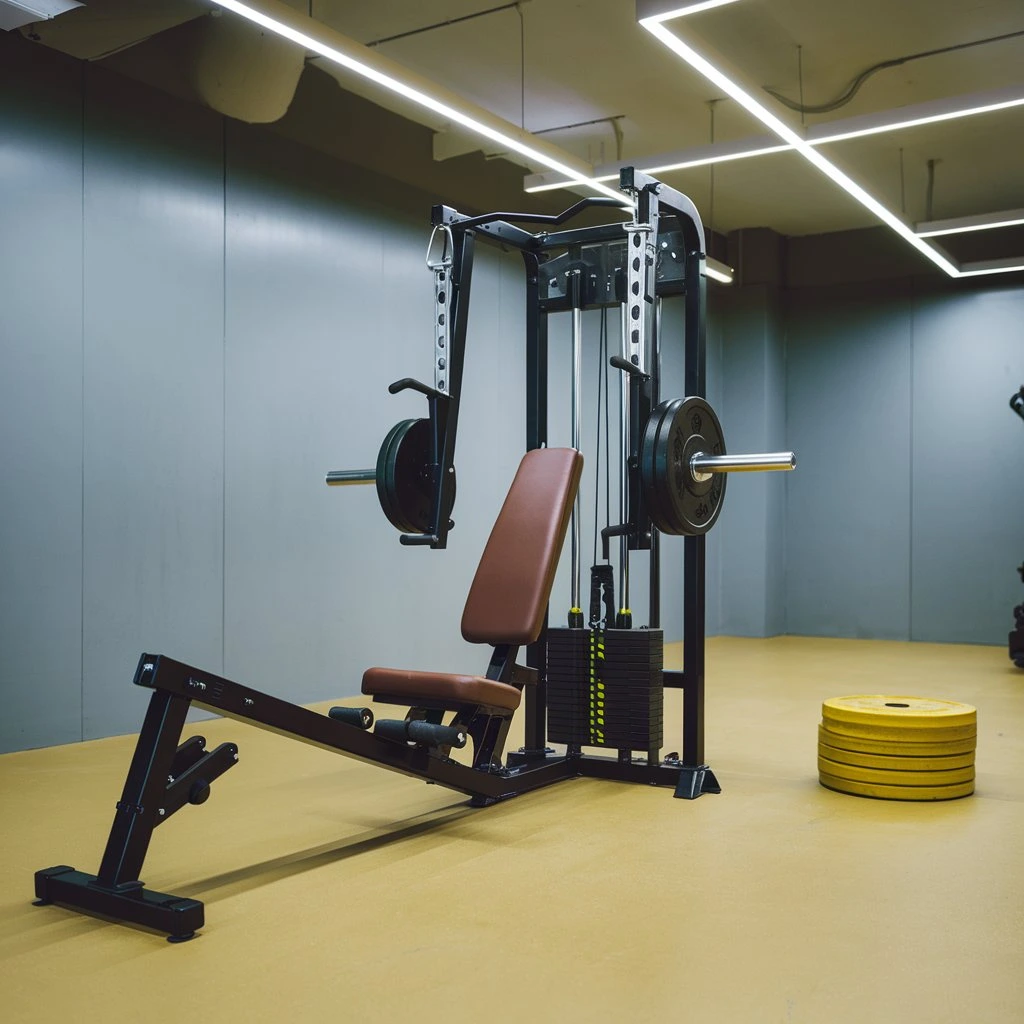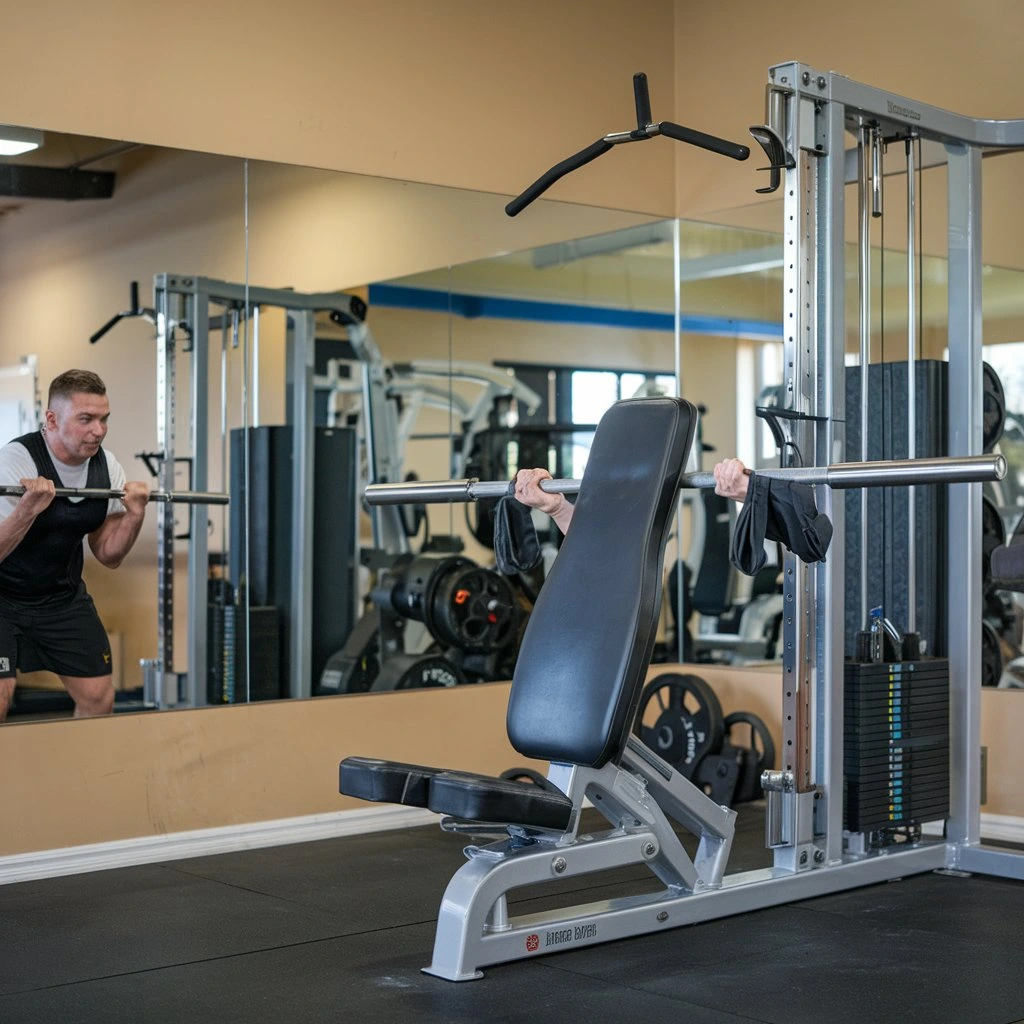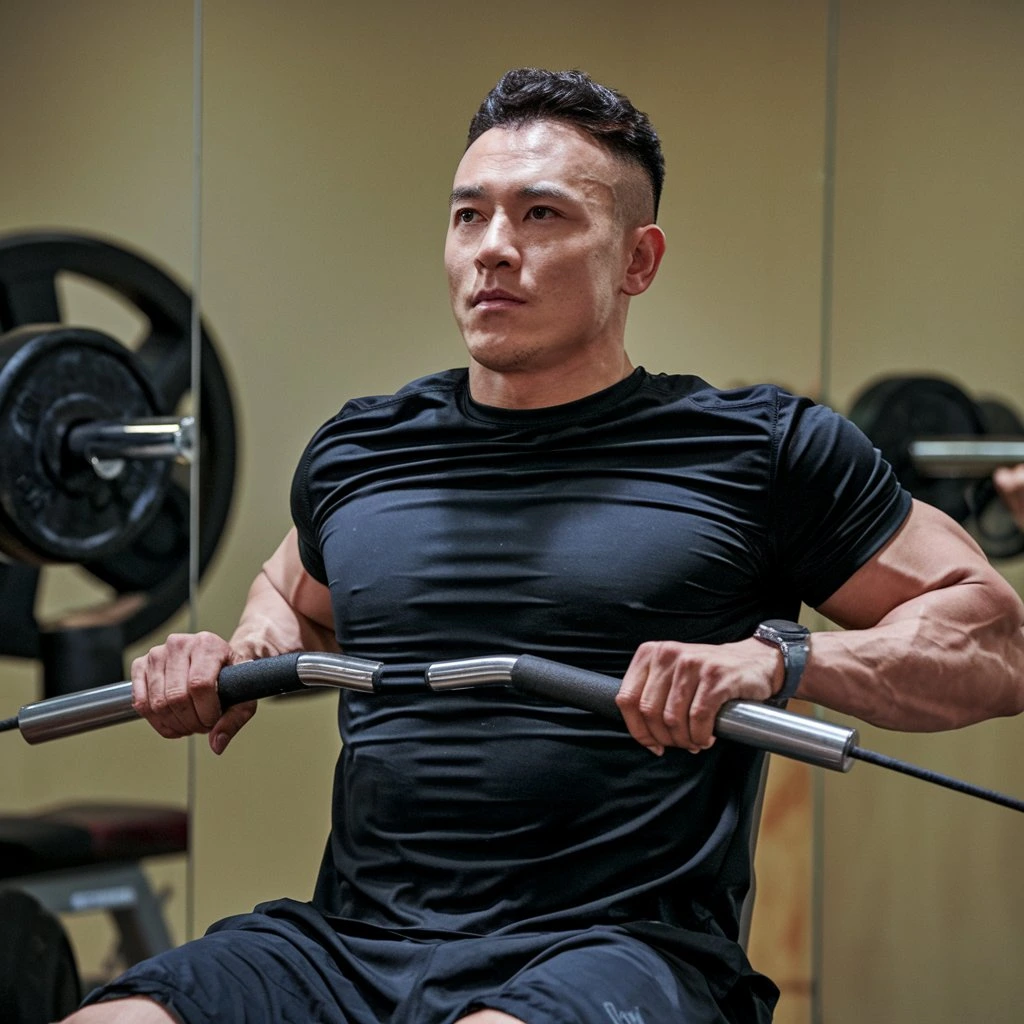The barbell row machine is a piece of exercise equipment commonly found in gyms. It’s designed to help people strengthen their back muscles and improve posture. It does this by letting them do rowing exercises. They use a barbell and adjustable resistance.
Brief History and Development
The barbell row machine idea came from the need to provide a safer and more controlled place for rowing. Over time, fitness fans and experts developed various designs. They aimed to make the machine work well and be comfortable.
Early versions of the barbell row machine were simple and often homemade. They had basic frames with attachments for holding the barbell. As weight training became more popular, fitness equipment makers began producing better designs. They were more sophisticated and ergonomic.

Today, barbell row machines come in various shapes and sizes. They have adjustable resistance levels, padded seats, and handles for better grip. These advancements have made the machine easier to use. It’s now accessible to people of all fitness levels.
Anatomy of the Barbell Row Machine
Components and Structure
The barbell row machine is usually made up of a few key parts. First, there’s the main frame. It’s like the skeleton of the machine. It provides support and structure. Attached to this frame, you’ll find a padded bench or platform where you can lie down. There’s also a bar attached to the frame, which you can pull up and down. This bar is connected to some weights, which you can adjust based on how heavy you want your workout to be.
Functionality and Mechanics
When you use the barbell row machine, you start by lying down on the bench or platform with your chest facing down. Then, you grab the bar with both hands and pull it up towards your chest while keeping your back straight. This exercise mainly works your back muscles, especially your upper and middle back. It’s kind of like mimicking the movement of rowing a boat, hence the name “barbell row.”

The weights on the machine provide resistance. They make your muscles work harder as you pull the bar up and down. The weight may be changed to correspond with your strength. Or, you can gradually increase it as you get stronger.
Safety Features
To keep you safe while using the barbell row machine, there are a few important features. First, there’s usually a lock that keeps the weights in place. It stops them from falling off while you’re working out. Also, the machine’s frame is designed to be sturdy and stable. It doesn’t wobble or tip over while you’re using it.
It’s also important to use proper form when using the machine. This is to avoid straining your muscles or injuring yourself. This means keeping your back straight. Use your back, not momentum, to lift the weight. If you’re unsure about how to use the machine safely, ask a fitness instructor or trainer for help.
How to Use the Barbell Row Machine
Proper Setup and Adjustments
- Adjust the seat height. Make it so that when you sit on it, your chest is at the same level as the machine’s handles.
- Make sure the footplates are secure and adjust them if needed so your feet are flat on them.
- Pick a weight for your fitness level. Then, place it on the machine’s weight stack.
- Using an overhand grip (palms facing down), grab the handles. Sit down on the seat with your chest up and shoulders back.
Correct Body Positioning and Posture
- Keep your feet flat on the footplates and your knees slightly bent.
- Your back should be straight, not rounded or arched. Imagine keeping your spine in a neutral position.
- Hold the handles with your arms fully extended. But, do not lock them out. Hold your hands slightly wider than the breadth of your shoulders.
Execution of the exercise
- Pull the handles toward your lower chest. Do this by retracting your shoulder blades and bending your elbows.
- Throughout the exercise, keep your elbows close to your body.
- Squeeze your back at the top. After that, gradually lower the handles once again.
- Repeat for the desired number of times. Keep control of the weight.
Common Mistakes to Avoid
- Avoid using momentum to lift the weight. To complete the action, concentrate on activating your back muscles.
- Don’t round your back or shrug your shoulders during the exercise, as this can lead to injury.
- Ensure you’re not pulling the weight too high, as this can strain your shoulders and neck.
- Avoid using excessive weight that compromises your form. It’s better to use lighter weights with proper form than heavy weights with poor form.
Benefits of Using the Barbell Row Machine
Muscle Groups Targeted
The barbell row machine is great because it works out several muscles at once. It mainly targets your back muscles. These include the lats. They are the big muscles on your sides. Also, the rhomboids are between your shoulder blades. And the traps are on your upper back. Plus, it also helps strengthen your biceps and forearms.
Strength and Muscle-Building Advantages
One of the best things about using the barbell row machine is that it helps you get stronger and build muscle. Since you’re pulling the weight towards you, it’s like doing a reverse push-up, but for your back. This increases your strength. It makes your back muscles bigger and more defined over time.
Improvements in Posture and Back Health
The barbell row machine has another cool feature. It can help improve your posture and keep your back healthy. When you do rows, you’re working those muscles in your back that help you stand up straight. Over time, as you get stronger, you’ll find it easier to keep your shoulders back and your spine aligned. This can stop back pain and other problems.
Versatility for Various Fitness Goals
The barbell row machine is super versatile, which means it’s great for all kinds of fitness goals. It can assist you in gaining strength and muscle. It can also help you maintain your health and correct your posture. Also, you can adjust the weight and the angle of the bench. This makes the exercise harder or easier, as you need. So, no matter what your goals are, the barbell row machine can help you reach them.
Variations and Modifications
Grip Variations
- Overhand grip: Hold the bar with your palms facing down, which works on your upper back muscles.
- Underhand grip: Grab the bar with your palms facing up, focusing more on your biceps and lower back.
- Mixed grip: One hand is overhand and the other is underhand. This grip gives better stability and targets both sides of your back evenly.
Foot Positioning Adjustments
- Wide stance: Place your feet wider apart. Your base will become more stable as a result. It will let you lift heavier weights with better balance.
- Narrow stance: Bringing your feet closer together can increase the challenge. It does so by engaging your core more and requiring better balance control.
- One foot forward: Try putting one foot slightly in front of the other. This isolates each side of your back. It enhances muscle symmetry.
Implementing Different Rep Ranges and Intensity Techniques
- High reps, low weight: Do high reps with low weight. Do 12-15 reps with lighter weights. This focuses on muscle endurance and definition.
- Low reps, high weight: Lift heavier weights for 6-8 reps to build strength and muscle mass.
- Drop sets: Perform 6–8 repetitions with a heavy weight at first. Then, quickly decrease the weight and keep lifting until failure. This will fully exhaust your muscles.
- Supersets: Pair barbell rows with another exercise. For example, push-ups or shoulder presses. This will intensify your workout and target multiple muscle groups.
Integration with other Exercises
- Superset with deadlifts: Do barbell rows and deadlifts on different days. They work your back and lower body at the same time.
- Combine with bent-over dumbbell rows: Do barbell rows and dumbbell rows on different days. This targets different angles of your back muscles. It gives you a complete workout.
- Pair with pull-ups: Do sets of pull-ups. Then, do barbell rows. Or, do them in the reverse order. This will engage back muscles more and boost upper body strength.
Safety Considerations and Precautions
Warm-Up and Preparation
Before using the barbell row machine, warm up your muscles and joints. This reduces the risk of injury. You can do this by doing light cardio. This could be jogging or cycling. Do it for about 5-10 minutes to get your blood flowing. Also, do some dynamic stretches. They should target the muscles you’ll use, like the back, arms, and shoulders. They can help prepare your body for the workout. Start with lighter weights or resistance. This will warm up the specific muscles you’ll be working on the rowing machine.
Proper Progression and Weight Selection
When using the barbell row machine, start with a weight that lets you keep proper form. Start with a lighter weight. Focus on mastering the movement. Then, slowly increase the resistance. Avoid the urge to lift too heavy too soon. This can raise injury risk and harm your form. As you get stronger and more comfortable with the exercise, you can slowly add more weight.
Monitoring Fatigue and Form Breakdown
It’s crucial to watch for signs of fatigue and form issues. This is while using the barbell row machine. As you do the exercise, be mindful of too much strain or discomfort in your muscles or joints. If you notice your form getting worse, like rounding your back or using momentum, you may need to lift less. Maybe you ought to get a rest as well. Pushing through fatigue with poor form can raise injury risk. So, listen to your body and prioritize using proper technique.
Injury Prevention Strategies
To prevent injuries when using the barbell row machine, you can use many strategies. First, make sure the machine is set up correctly for your height and body. This will give you the best support and range of motion. Also, keep your back straight. Avoid too much rounding or arching. This will keep your spine neutral. Engage your core muscles to stabilize your torso and support your lower back. You must use controlled movements. Don’t rely on momentum to lift the weight. It can stress your joints and muscles. Finally, always use collars to hold the weights on the barbell. This prevents them from sliding off.
Maintenance and Care of the Equipment
Cleaning and Sanitation
- Wipe down the machine after each use with a clean, damp cloth to remove sweat and dirt.
- Use a mild detergent or cleaning solution to sanitize the surfaces regularly.
- Pay special attention to areas where sweat accumulates, such as handles and seat pads.
- Before using the machine again, let it air dry thoroughly.
Regular Inspections for Wear and Tear
- Check the cables, pulleys, and chains for any signs of fraying, rust, or damage.
- Inspect the frame and structural components for cracks or bending.
- Ensure that all bolts, nuts, and screws are tight and secure.
- Look for any loose or broken parts that may affect the machine’s performance or safety.
- If you notice any issues, avoid using the machine until it has been repaired or replaced.
Lubrication and Upkeep of Moving Parts
- Oil the pivot points, joints, and moving parts of the machine often. This prevents friction and wear.
- Use the oil or lubricant on a silicone basis that the manufacturer recommends.
- Use a little lubricant. Then, wipe off any extra. By doing this, dust and dirt won’t stick.
- Check the tension of the cables and chains. Adjust them as needed to keep them running smoothly.
- Keep the weight plates and loading pins clean and free from debris to ensure they move freely.
Conclusion
Recap of Key Points
We’ve explored the barbell row machine. It’s a valuable tool for building strength in the upper body, especially the back muscles. Its simple design and ease of use make it easy to use. This makes it accessible to beginners and seasoned gym-goers alike. Targeting muscles like the lats, traps, and rhomboids improves posture. It also cuts the risk of injury and boosts strength and stability.
Final Thoughts on the Significance of the Barbell Row Machine in Strength Training
The barbell row machine isn’t just another gadget in the gym. It’s a key tool for building a strong upper body. It can be used with various grip options. It can be adjusted for different body types and fitness goals. Using the barbell row machine in your workout can lead to big improvements. You’ll get stronger, more defined muscles, and better fitness. Are you aiming to increase your deadlift? Or, do you simply want a stronger back for everyday tasks? This machine has got you covered.
Encouragement for Safe and Effective Use
As with any exercise equipment, you must prioritize safety and proper form. This is crucial when using the barbell row machine. Start with a weight that allows you to perform the exercise with control and good technique. Keep a neutral spine. Engage your core. Pull the barbell to your lower chest. Keep your elbows close. Avoid excessive swinging. Also, avoid using momentum to lift the weight. Doing so can increase the risk of injury. Practice consistently and progress slowly. You’ll gain from this exercise’s strength-building power. It will also cut the risk of setbacks. Remember, safety first, and happy lifting!

